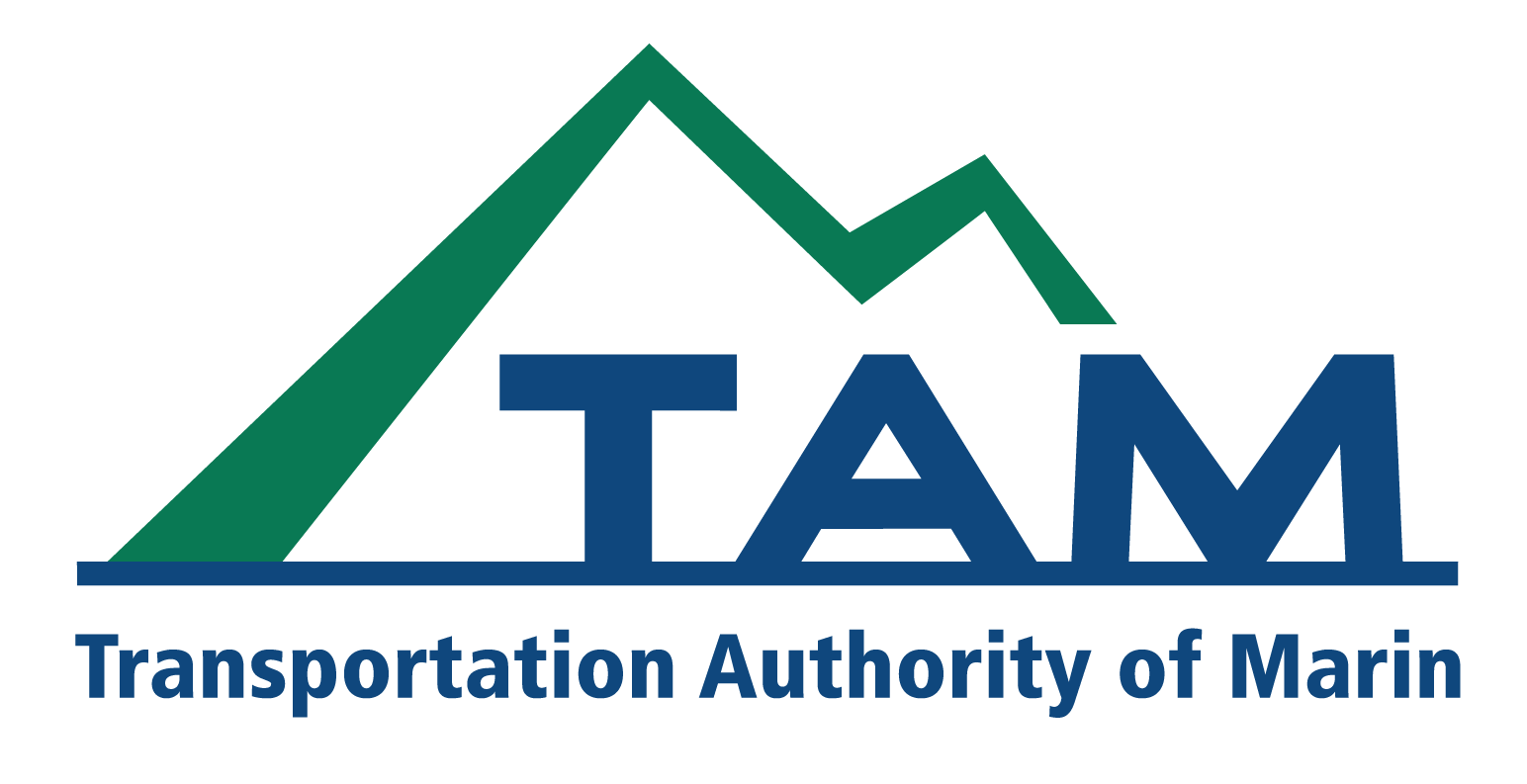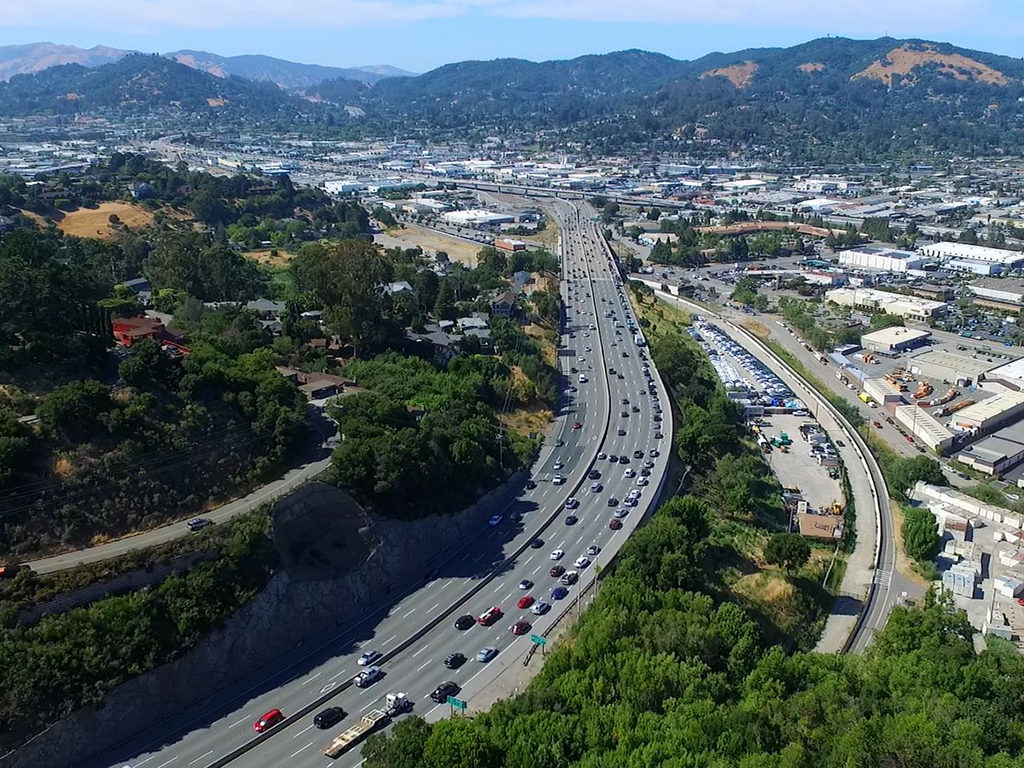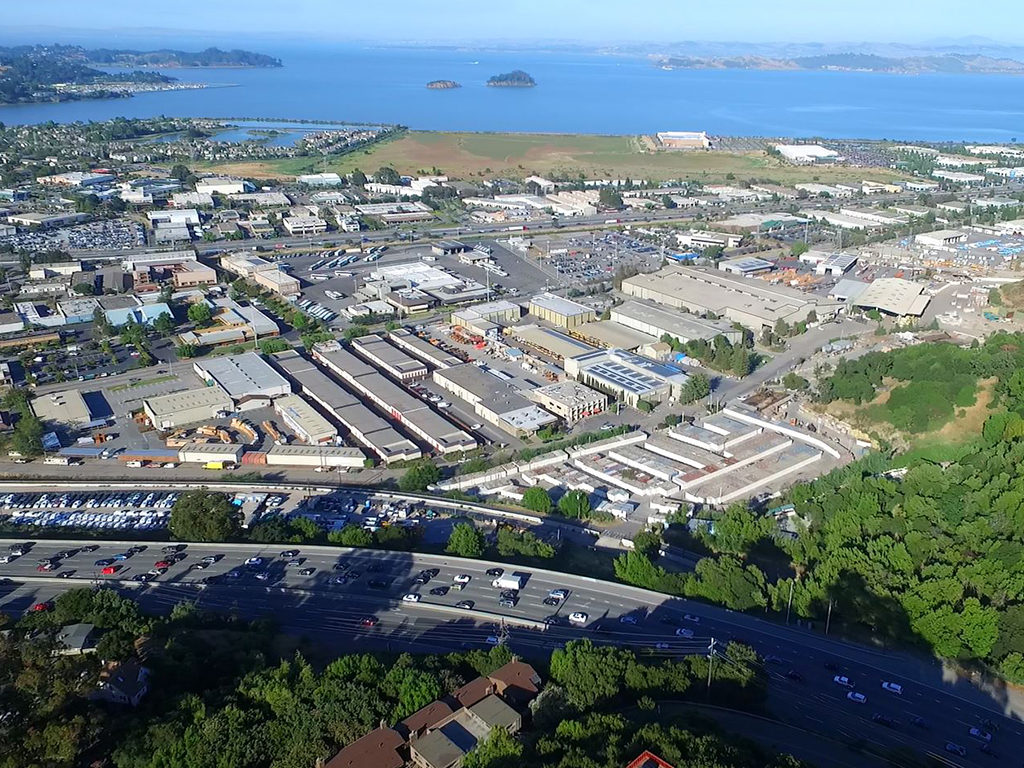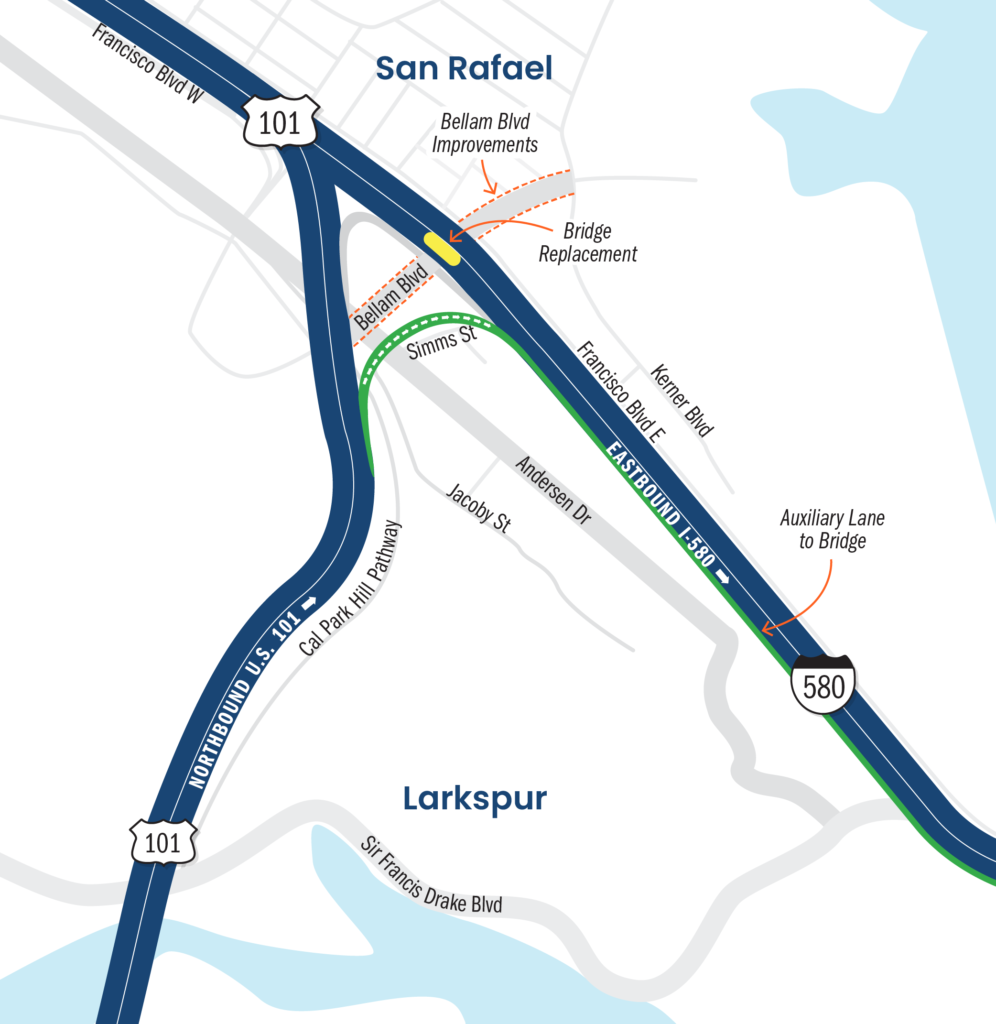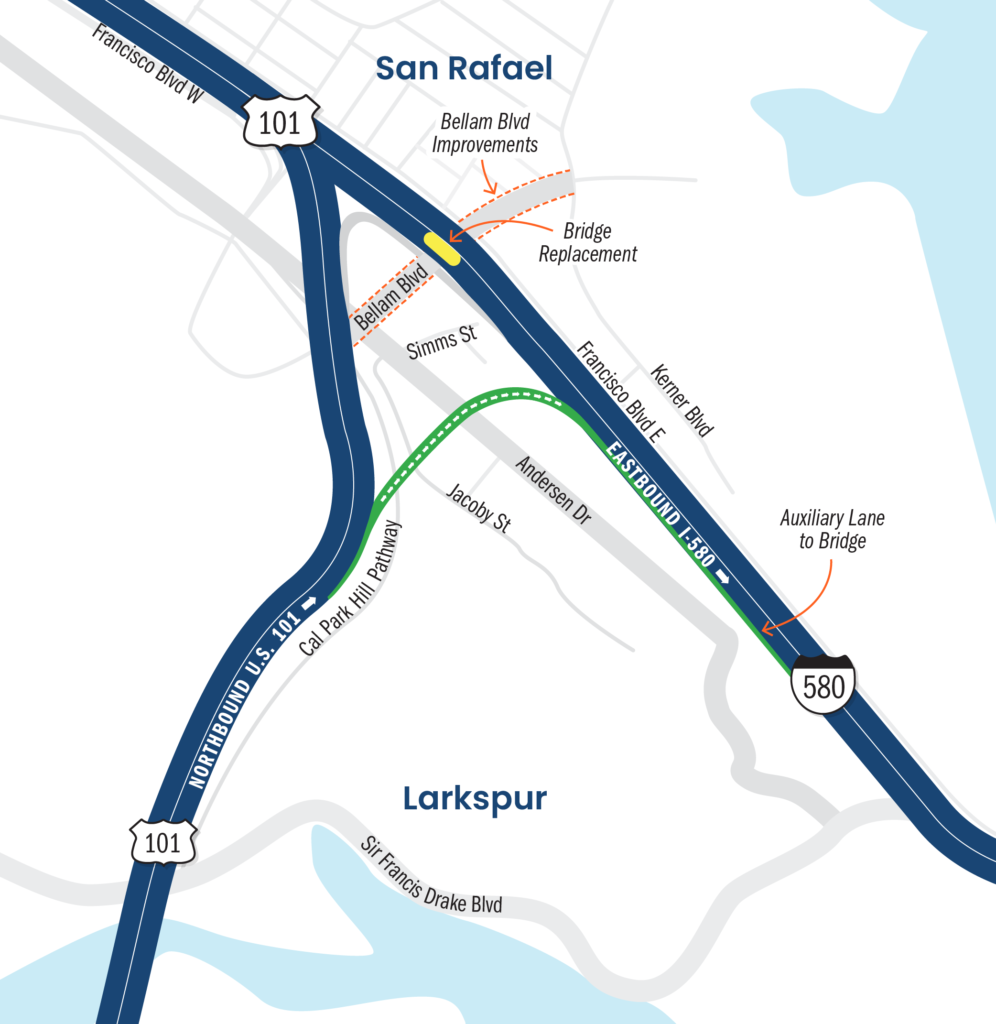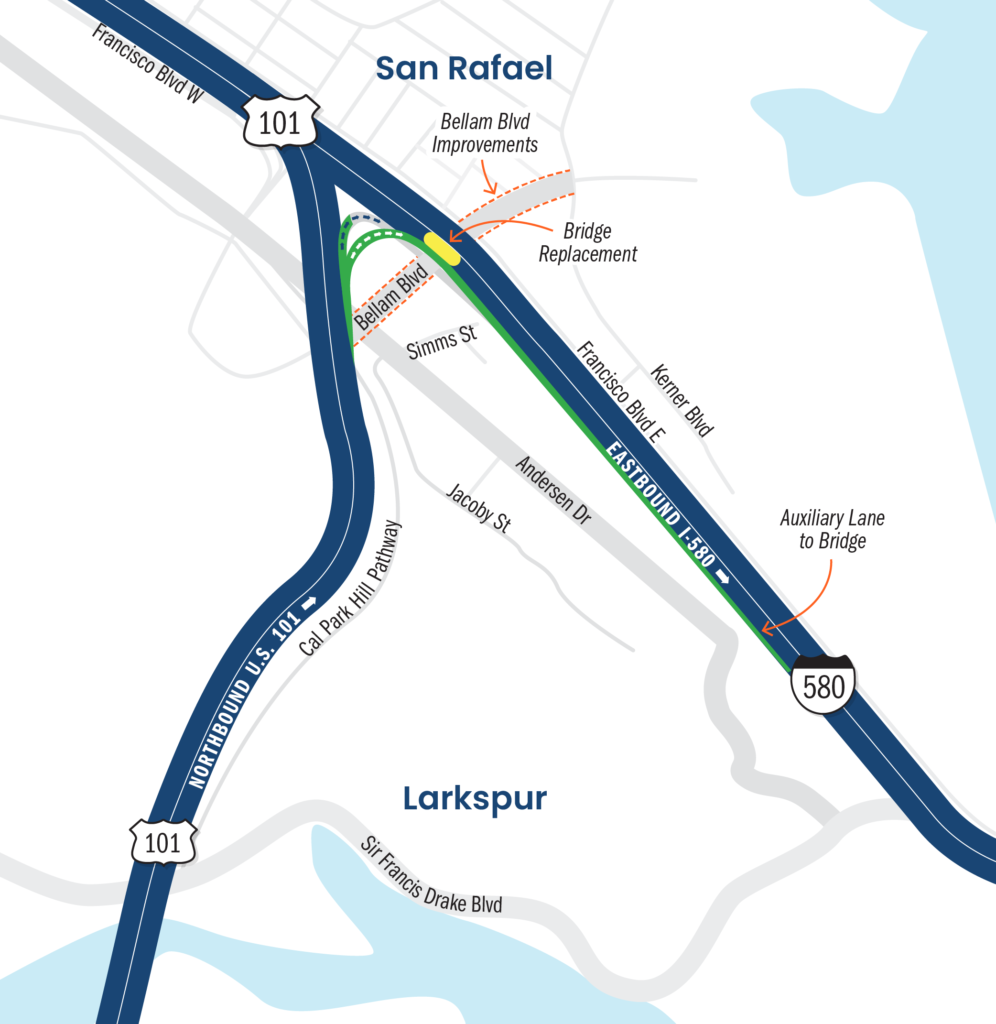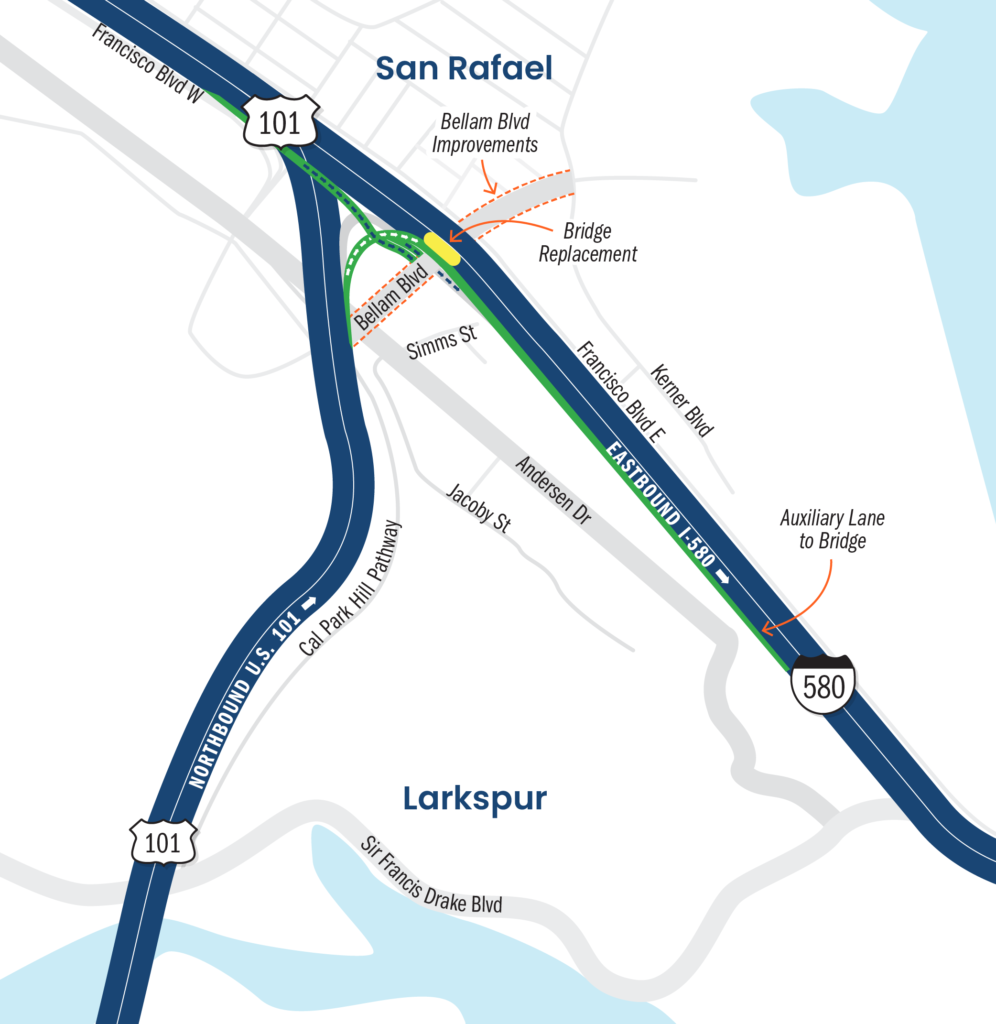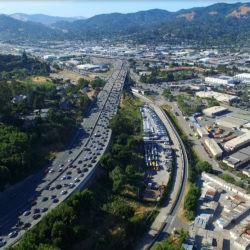
The Transportation Authority of Marin (TAM) is planning a proposed project to construct a freeway-to-freeway direct connection from northbound US 101 to eastbound Interstate 580 in Marin County.
TAM expects to initiate the environmental review and continue community engagement in 2023, with the goal of deciding on a preferred alternative by the end of 2025. Design and construction would take approximately seven years after the environmental document is approved, pending availability of funds.
This project is a collaborative effort among TAM, the California Department of Transportation (Caltrans), and the cities of San Rafael and Larkspur.
Currently, drivers who wish to access the Richmond-San Rafael Bridge (I-580) via northbound US 101 in Larkspur must exit the freeway and travel on East Sir Francis Drake Boulevard in Larkspur or across Bellam Boulevard in San Rafael to I-580 and the bridge entrance. Highway drivers on local streets cause congestion and traffic delays on Sir Francis Drake Boulevard, Bellam Boulevard, and northbound US 101.
The proposed project would allow vehicles to continue along US 101 northbound onto a new, separated highway connector in San Rafael and merge directly onto I-580.
The connector will be two lanes, with the possible addition of a third lane for High-Occupancy Vehicle (HOV) bypass. Regardless of which alternative is chosen, additional benefits from this project include:
- Replacement of the eastbound Bellam Boulevard undercrossing.
- Bicycle and pedestrian infrastructure improvements along Bellam Boulevard.
- Addition of an eastbound auxiliary lane on I-580.
Existing Conditions
Proposed Alternatives
Alternative 2
Est. cost $241M (Visual simulation)
Drivers would exit US 101 northbound between the top of Cal Park Hill and the Bellam Boulevard off-ramp. The connector would be an elevated structure that crosses Andersen Drive and follows the alignment of Simms Street before merging with I-580 eastbound.
Alternative 6
Est. cost $315M (Visual simulation)
Drivers would exit US 101 northbound between the top of Cal Park Hill and the Bellam Boulevard off-ramp. The connector would be an elevated structure that crosses over Jacoby Street, Andersen Drive, and the Golden Gate Bridge Highway & Transportation District bus yard before merging with I-580 eastbound.
Alternative 3A
Est. cost $192M (Visual simulation)
Drivers would exit US 101 northbound near Bellam Boulevard and merge onto I-580 eastbound on a connector that crosses over the existing northbound US 101 / eastbound I-580 off-ramp.
Alternative 3B Modified
Est. cost $200M (Visual simulation)
Drivers would exit US 101 northbound on a separate lane near Bellam Boulevard and merge onto I-580. The off-ramp from eastbound I-580 to Bellam Boulevard would be replaced with a new, separated off-ramp.
TAM is engaging community members and interested stakeholders throughout project planning. To date, TAM has conducted meetings and briefings with community organizations, convened a Stakeholder Working Group (see below), and held meetings with technical and management staff with cities, the County of Marin, and transit organizations. In 2023, TAM will initiate the environmental review of four proposed alternatives, during which there will be opportunities for community engagement and public comment on the scope of the environmental analysis, improvement concepts for Bellam Boulevard, and the draft environmental impact report.
Before the environmental review phase, TAM will be working closely with community organizations to implement an equity engagement approach to ensure all voices are heard in project planning. The activities will inform and involve underserved residents in the project area to build their capacity to participate and increase their involvement in community discussions.
Community Working Group – Environmental Phase
TAM reconstituted the Stakeholder Working Group (SWG) that was initiated in 2020 as the Community Working Group to provide community input to the project team during the environmental phase.
The committee is comprised of volunteers representing diverse interests in the project area, including business, community organizations, and commuters. The CWG meetings are open to the public and public comments are taken at the meetings.
Details on upcoming meetings, agendas, access/log-in information (virtual) and meeting locations (in-person) will be posted on the Calendar Page at least 72 hours prior to each meeting.
CWG Meeting 1 – Wednesday, May 1, 2024 – CWG introductions and recap/overview – View the agenda
Stakeholder Working Group – Planning Phase
TAM established a Stakeholder Working Group (SWG) to provide community input to the project team. The SWG provided a forum to discuss initial project concepts and features and for the project team to understand community concerns early in the project development process.
The committee is comprised of volunteers representing diverse interests in the project area, including business, community organizations, and commuters. The SWG meetings are open to the public and public comments are taken at the appropriate times.
Details on upcoming meetings, agendas, access/log-in information (virtual) and meeting locations (in-person) will be posted on the Calendar Page at least 72 hours prior to each meeting.
SWG Meeting 7 – Wednesday, October 11, 2023 – An overview of project progress, timeline and upcoming outreach – View the agenda, presentation, and notes.
SWG Meeting 6 – Tuesday, May 18, 2021 – Input on project alternatives – View the agenda and presentation. Review the handbook for an overview and visuals of the proposed alternatives. View meeting notes and summary slides for the recap of meeting input, discussion, and background on funding commitments.
SWG Meeting 5 – Monday, April 26, 2021 – Prior concepts, new and modified alternatives, review of all alternatives – View the agenda, presentation, and notes.
SWG Meeting 4 – Wednesday, January 20, 2021 – Equity considerations – View the agenda, presentation, and notes.
SWG Meeting 3 – Tuesday, August 25, 2020 – Bellam Boulevard improvements and additional information about project alternatives – View the agenda, presentation, and notes.
SWG Meeting 2 – Tuesday, July 21, 2020 – Project Alternatives and discussion – View the agenda, presentation, and notes.
SWG Meeting 1 – Monday, June 29, 2020 – SWG introductions and overview – View the agenda, presentation, and notes.
US 101/I-580 Multi-Modal and Local Access Improvement Project
1. What are the Transportation Authority of Marin (TAM) project goals for the US 101/I-580 Multi-Modal and Local Access Improvement project?
The four alternative concepts (2, 3A, 3B Modified, and 6) have been specifically selected to achieve these project goals:
- Build a new freeway-to-freeway connection between northbound US 101 and eastbound I-580 to improve connectivity and traffic flow for local and regional traffic.
- Separate regional pass-through traffic from local traffic and reduce local traffic congestion.
- Enhance the bicycle and pedestrian networks and local access within the project area.
- Promote equity for all users, particularly members of the underrepresented communities within the project area.
The project team will also consider allowing space for the future construction of a westbound I-580 to southbound US 101 connector.
Project Alternatives
2. What are the alternatives for the US 101/I-580 Multi-Modal and Local Access Improvement project?
TAM approved four alternative concepts, plus a no-build alternative, to study further in the environmental review phase. These four alternatives were selected from a list of nine initial alternatives.
Each alternative would provide a direct freeway-to-freeway connector between northbound US 101 and eastbound I-580 toward the Richmond-San Rafael Bridge.
The following alternative concepts are under consideration:
Alternative 2, Simms Street
Drivers would exit US 101 northbound between the top of Cal Park Hill and the Bellam Boulevard off-ramp. The connector would be an elevated structure that crosses Andersen Drive and follows the alignment of Simms Street before merging with I-580 eastbound.
Alternative 3A
Drivers would exit US 101 northbound near Bellam Boulevard and merge onto I-580 eastbound on a connector that crosses over the existing off-ramp.
Alternative 3B Modified
Drivers would exit US 101 northbound on a separate lane near Bellam Boulevard and merge onto I-580. The off-ramp from eastbound I-580 to Bellam Boulevard would be replaced with a new, separated off-ramp.
Alternative 6, Andersen Mid-Way
Drivers would exit US 101 northbound between the top of Cal Park Hill and the Bellam Boulevard off-ramp. The connector would be an elevated structure that crosses over Jacoby Street, Andersen Drive, and the Golden Gate Bridge Highway & Transportation District bus yard before merging with I-580 eastbound.
Each of the proposed alternatives, except the no-build alternative, would also include the following improvements:
- A new eastbound auxiliary lane on I-580 from the new connector merge point to the Richmond-San Rafael Bridge.
- Replacement of the eastbound I-580 bridge over Bellam Boulevard with a single-span bridge (removing the columns beneath the bridge).
- Traffic, pedestrian, and bicycle improvements on Bellam Boulevard.
- Ramp metering of the Sir Francis Drake Blvd on-ramp and signal timing on Sir Francis Drake Boulevard between US 101 and I-580.
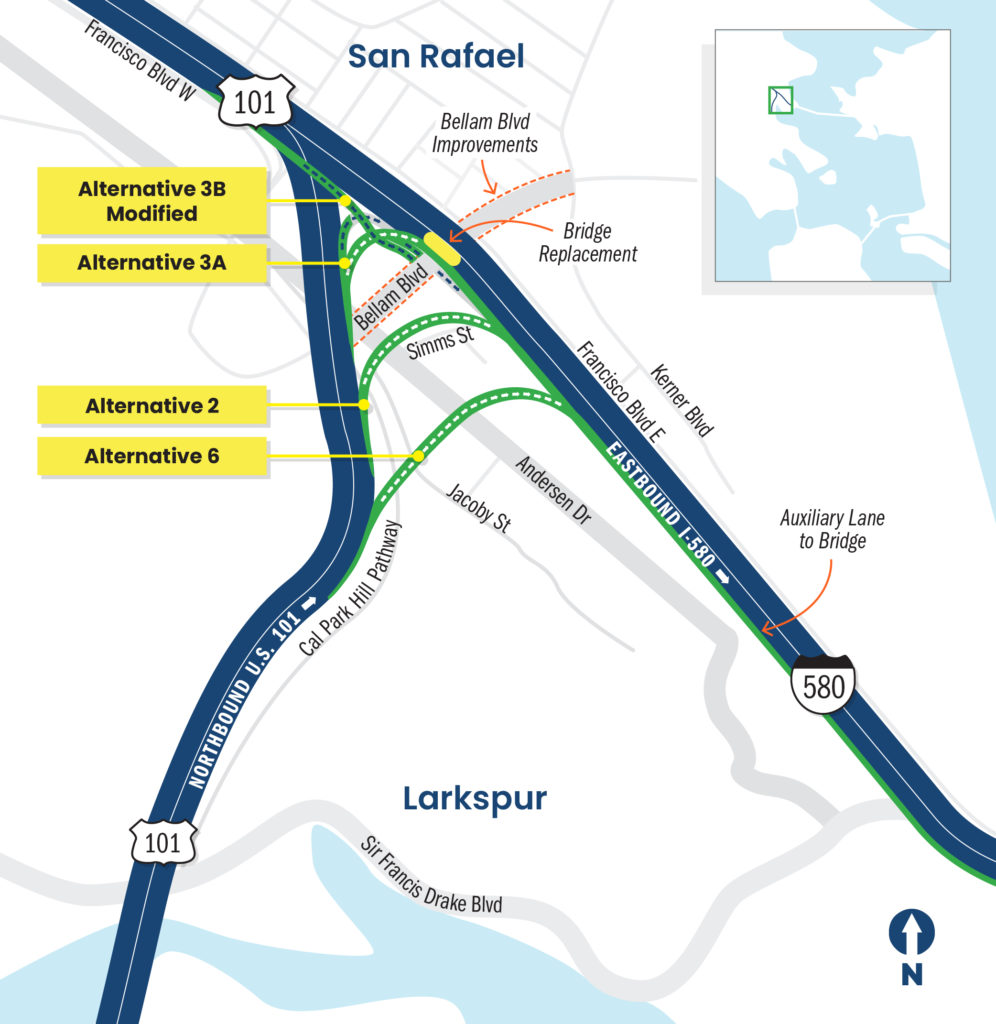
3. Why are there no connector alternatives in Larkspur?
TAM did an extensive evaluation of potential alternatives in Larkspur, including a hillside option, an elevated structure over Sir Francis Drake, and options to widen Sir Francis Drake in one or both directions. Due to potential construction, environmental, and visual impacts along the waterfront, including impacts to the Bay, ferry, and SMART transit access, those alternatives were eliminated from further consideration. In addition, an on-street Sir Francis Drake option does not achieve the project goal of separating local and regional traffic. Obtaining the necessary regulatory approvals would be challenging for several of these options.
Larkspur Landing is one of Marin’s multimodal transit hubs. Redirecting regional traffic off Sir Francis Drake will reduce congestion on Sir Francis Drake Boulevard and improve access to the various transit connections and therefore improve connectivity for all residents of the county.
In 2018, TAM completed significant improvements to facilitate better access for cars and cyclists to the Richmond-San Rafael Bridge from Marin County, increase local access to adjacent businesses and communities, and provide safe connections for bicycles and pedestrians. These improvements included widening East Sir Francis Drake Boulevard and relocating the eastbound lane drop to reduce congestion and extending the turn pocket on East Sir Francis Drake Boulevard turning onto Larkspur Landing Circle East to allow more cars to queue. (See #7)
4. Will Sir Francis Drake Boulevard and Bellam Boulevard continue to carry traffic if the US 101/I-580 Multi-Modal and Local Access Improvement project is built?
Yes, local traffic will still be able to access I-580 from Sir Francis Drake Boulevard and Bellam Boulevard. In addition, the local arterial signals and the freeway ramp meters will be re-timed and coordinated to encourage the regional traffic to use the new connector and allow the local traffic to continue to use the local arterials.
5. Why would people go out of their way to San Rafael to get to the Richmond-San Rafael Bridge?
The goal of the US 101/I-580 Multi-Modal and Local Access Improvement project is to create a freeway-to-freeway connector that provides a travel time advantage for the regional traffic to stay on the connector and off local streets.
During the environmental review process, the project team will evaluate current and future traffic movements and the travel times for both local and regional traffic. The traffic analysis will show travel times to the Richmond-San Rafael Bridge for each direct connector alternative.
Traffic Conditions
6. Where is the regional traffic on the Richmond-San Rafael Bridge going?
Approximately 85% of the traffic on the Richmond-San Rafael bridge is going to or from destinations within Marin County.
Less than 5% of the Richmond-San Rafael Bridge traffic is going through Marin County to and from the Golden Gate Bridge and San Francisco.
About 10% of the Richmond-San Rafael Bridge traffic is going to and from Sonoma County.
7. What are current and projected traffic levels on Sir Francis Drake Boulevard and the Bellam interchange?
During the afternoon commute (3:00 to 7:00 p.m.), pre-COVID, approximately 5,300 vehicles used Sir Francis Drake to access the Richmond-San Rafael Bridge. During the same commute time, approximately 3,500 vehicles exited from northbound US 101 to Bellam Boulevard. Of these vehicles, approximately 12% continued across Bellam to the Richmond-San Rafael Bridge.
| Northbound US 101 to Richmond-San Rafael (RSR) Bridge and Bellam Boulevard Afternoon Commute (3:00 to 7:00 p.m.) | |
|---|---|
| Percent of total northbound US 101 traffic going to the Richmond-San Rafael Bridge | 20% |
| Via Sir Francis Drake Blvd. to RSR Bridge | 5,300 vehicles |
| Total Vehicles Exiting at Bellam Blvd. | 3,500 vehicles |
| Vehicles Continuing across Bellam Blvd. to RSR Bridge | 410 vehicles (12%) |
| Travel Time Today: Tamalpais Blvd. (Corte Madera) to Bellam Blvd. (San Rafael) | 13 minutes |
| Travel Time 2040: Tamalpais Blvd. (Corte Madera) to Bellam Blvd. (San Rafael) | 25 minutes |
In the last few years, TAM funded improvements on Sir Francis Drake to reduce congestion by adding additional lanes and improving signal timing. Today, as a result of these reduced travel times, almost all traffic from northbound US 101 to the bridge is now taking Sir Francis Drake. Unfortunately, future traffic growth will increase congestion on Sir Francis Drake and further traffic improvements are not feasible. Therefore, future traffic will opt for the Bellam off-ramp, increasing congestion there. Traffic modeling for future conditions shows that the travel time for vehicles on northbound US 101 from Tamalpais Boulevard in Corte Madera to Bellam Boulevard will double, from 13 minutes to 25 minutes in 2040, primarily due to congestion on the Bellam off-ramp.
The most effective way to eliminate the increase in travel time for drivers exiting to Bellam is to separate the regional traffic from the local traffic with a direct connector. The planned traffic analysis will consider traffic volumes and travel times, including future land uses identified in city and county general plans and specific development proposals known at the time.
Near-term Improvements
8. Can Sir Francis Drake Boulevard be improved to carry more traffic?
Recently, TAM funded projects to widen Sir Francis Drake Boulevard in Larkspur and improve signal timing. These improvements, along with the addition of a third lane on the Richmond-San Rafael Bridge, made a significant difference in travel times to the bridge. Unfortunately, there is limited room to widen the local route on Sir Francis Drake without impacting the Bay. Constructing a freeway-to-freeway connector here would require constructing a bridge over or a tunnel under the two Larkspur Landing Circle intersections. This is not possible in this corridor due to the configuration of the local streets, conflict with the existing north-south greenway pedestrian overcrossing, ferry access, proximity to the shoreline, and other environmental constraints.
9. Can congestion problems at the Bellam interchange be addressed first, before the US 101/I-580 Multi-Modal and Local Access Improvement project?
TAM is funding a near-term project to widen the off-ramp from northbound US 101 to Bellam Boulevard. TAM expects this project to be approved and constructed by the end of 2024.
More substantial changes to traffic circulation and freeway on- and off-ramps at Bellam would require an environmental review before approval. The plan for the US 101/I-580 Multi-Modal and Local Access Improvement project has always been to look at Bellam Boulevard improvements along with the direct connector structure and complete environmental clearance on all elements at once. That approval process is likely to take two to four years, at which point TAM could consider project sequencing to construct Bellam improvements first, pending availability of funding.
In the meantime, TAM continues to support and fund local improvements such as the sidewalk improvements along Bellam Boulevard, Francisco Boulevard East (2009), and widening the Bellam off-ramp (coming soon).
Bellam Boulevard and East San Rafael
10. What are the problems and/or challenges at Bellam Boulevard?
There are several intersecting challenges around Bellam Boulevard, including:
- Close spacing of the traffic signals, which limits the storage capacity for stopped traffic and causes congestion at the Bellam Boulevard interchange and on Francisco Boulevard East.
- Intersections with multiple legs that allow all turn movements, which cause delays for all approaches because of the lengthy signal cycles required to allow time for all movements.
- Long crossings and limited space for pedestrians and bicycles, which increase potential conflicts for these users.
- Multiple driveways and the center turning lane interrupt traffic flow.
- Bridge columns under the eastbound I-580 undercrossing (this bridge would be replaced as part of the connector project, opening space for sidewalks and bicycle lanes).
- Limited access and egress to the Canal, Spinnaker, and Baypoint neighborhoods.
Planning for the US 101/I-580 Multi-Modal and Local Access Improvement project will help improve these conditions but is unlikely to completely address them. Further study of traffic circulation in and out of East San Rafael will need to be addressed in future planning studies such as the planned City of San Rafael’s Priority Development Area, which is awaiting funding (see #13).
11. How does the US 101/I-580 Multi-Modal and Local Access Improvement project address congestion on Bellam Boulevard?
As currently conceived, the direct connector project will include improvements along Bellam Boulevard regardless of which connector alternative is selected. TAM is considering the following improvements:
- Replacing the eastbound Bellam Boulevard undercrossing structure, which would provide more width for bike and pedestrian safety improvements.
- Improving traffic circulation and turn movement along the Bellam corridor and ramps.
- Increasing spacing and timing of the signals.
- Consolidating driveways.
During the environmental review, beginning in 2023, there will be extensive community engagement to discuss community priorities and feasibility of improvements.
12. What else can be done to address congestion, access, and egress for neighborhoods around Bellam Boulevard?
TAM acknowledges the complex local circulation challenges in East San Rafael affect access, egress, and congestion. The US 101/I-580 Multi-Modal and Local Access Improvement project is not intended to solve all issues. Continued coordination with the City of San Rafael and other organizations will be important to address the broader circulation challenges in East San Rafael.
13. Can TAM develop a comprehensive plan for the transportation challenges in East San Rafael?
TAM will continue to explore transportation solutions throughout the county, including cooperation with local transportation studies, such as in East San Rafael. The City of San Rafael is taking the lead on several planning activities. For example, the City of San Rafael is conducting a community-based transportation plan focused on East San Rafael. Additionally, the East San Rafael area has been identified as a Priority Development Area for the region, making it eligible for regional grants to conduct land use planning and transportation studies. TAM will assist the City of San Rafael in pursuing grant funds to conduct those studies and continue to look at transportation challenges and solutions as part of those studies.
Project Evaluation
14. How will TAM consider San Rafael and Larkspur’s guiding principles for the project?
Both the cities of San Rafael and Larkspur have adopted guiding principles for the project to help direct their decision making. During the environmental review and decision-making process, TAM and Caltrans will continue to consider input from all the affected cities, the county, and the community. The cities of San Rafael and Larkspur’s guiding principles are an important part of the evaluation and continued community discussion around the US 101/I-580 Multi-Modal and Local Access Improvement project alternatives.
15. When will the traffic, air quality, and greenhouse gas emissions analysis be complete?
These analyses and other topic areas are important parts of the environmental review process, which TAM expects to initiate in 2023 and complete within two years. The traffic analysis will consider both local and regional traffic movements in Larkspur and San Rafael.
16. How is the team considering equity?
TAM is committed to equity and includes it as a guiding principle in its 2017 Vision Plan with a goal of maximum mobility for all people.
Many community organizations and project stakeholders have expressed concern about equity and how the project will address it. In response, TAM intends to implement an outreach and education plan that will begin in 2023, in parallel with the start of the environmental phase.
The engagement approach is a community-centered model to create opportunities for effective, authentic, meaningful, and sustained partnership with communities in the project area. For example, relative to other stakeholder groups, communities in and around the Canal neighborhood require greater support. The proposed community engagement plan will provide an opportunity to invest in community participation more strategically while being responsive to the context and the barriers to engagement.
TAM intends to expand community engagement throughout the project area to ensure that all community members are included in the discussions of connector alternatives and proposed improvements to Bellam Boulevard.
Future Conditions
17. How does the US 101/I-580 Multi-Modal and Local Access Improvement project fit with changing work patterns and long-term efforts to reduce traffic?
Although more people are working from home, recent traffic numbers show single-driver cars and other vehicles are back to prepandemic levels. TAM continues to evaluate traffic patterns and will support efforts to explore transportation solutions throughout Marin.
Transit is an important aspect of the overall transportation system. TAM continually evaluates and funds transit improvements. Specifically, TAM is exploring means to increase transit links between the East Bay and Marin in collaboration with regional transit providers such as Golden Gate Transit. TAM has a commute assistance program to incentivize commuters to take public transportation as an alternative to driving. Moreover, the project does not preclude future implementation of transit priorities such as carpool/bus-only lanes and bus priority signals.
18. How does this connector project relate to the third lane project on the Richmond-San Rafael Bridge?
TAM is working to reduce bottlenecks and backups on eastbound I-580 as it approaches the Richmond-San Rafael Bridge. In collaboration with the Metropolitan Transportation Commission (MTC), Caltrans, and Contra Costa Transportation Authority (CCTA), a third lane has been opened on the bridge to help alleviate heavy traffic. The third lane now extends from the existing I-580 on-ramp from East Sir Francis Drake Boulevard to the bridge.
As part of the new US 101/I-580 Multi-Modal and Local Access Improvement project, a new lane will be built along eastbound I-580 from the new connector entry point to the existing on-ramp from East Sir Francis Drake Boulevard. This auxiliary lane will allow drivers to use three lanes from the new connector all the way onto the bridge and into Richmond.
19. Can public transportation improvements be implemented at the same time or as part of the US 101/I-580 Multi-Modal and Local Access Improvement project alternatives?
TAM’s expenditure plan for Marin County includes investments in transit and other alternative transportation. The planned Bellam Boulevard improvements are intended to meet the needs of multiple modes of transportation, not just cars.
20. How will you address potential homelessness around freeway structures?
The California Department of Transportation (Caltrans), a state agency, owns all the lands under the freeway structures, and where possible and safe, Caltrans reuses the land productively, as in the case of the parking lot under US 101 in downtown San Rafael. In other cases, Caltrans secures the land to prevent public access.
Participation and Decision Making
21. How is the team engaging neighborhoods in East San Rafael, including the Canal neighborhood?
TAM is planning a robust community engagement process during the environmental review phase. Topics will include issues such as biology, air quality, traffic analysis, cultural resources, land use and planning, environmental justice, and human impacts. There will be extensive community engagement, and the feedback gathered could be incorporated into this project.
The planning effort will also include work in the Canal neighborhood and other parts of the project area to build the capacity for local residents to participate and engage thoroughly and constructively in transportation planning for East San Rafael.
22. What is the timeline? When will the decisions be made?
TAM expects to initiate the environmental review process in 2023, and to continue community engagement during the process with the goal of deciding on a preferred alternative by the end of 2025.
Following the selection of a preferred alternative, design, land acquisition, and construction are expected to take approximately seven years.

